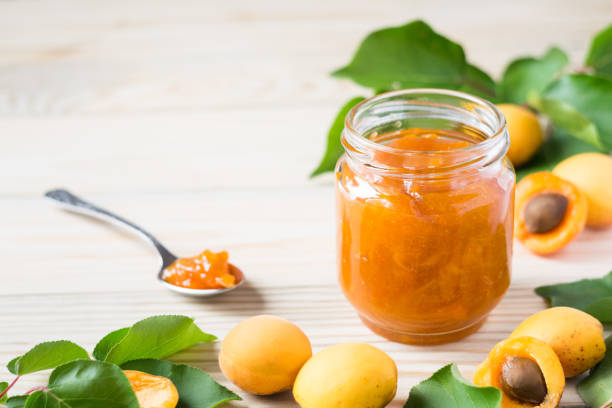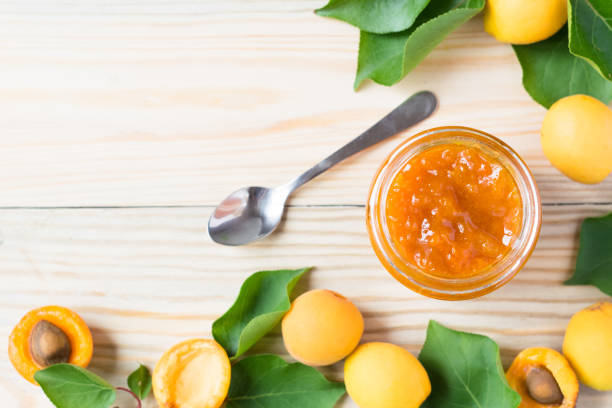Apricot Jam Recipe
The art of jam-making, or making homemade jam, is one of those indescribable practices that best conveys the true taste of summertime. From the wealth of fruity jam recipes, this apricot jam recipe deserves to be a savvy choice to fully enjoy due to the sweetness and sourness balance. This all-rounder spread is great on slices of bread, toast, crackers, or tarts as a filling for the pastries. If you are looking for a simple-to-make but fantastic apricot jam recipe, you have reached the goal you wanted to reach.

The Beauty of Apricots:
Apricots are gifts of nature when you see their amber-orange hue and the velvety texture that turns in your mouth. These attractive stones not only contain but also critical nutrients, which include carotene, vitamin C, vitamin E, dietary fiber, and potassium. In this case, the conversion of their natural sweetness and light acidity into an apricot jam recipe allows the creation of a well-balanced flavor that will satisfy your people.
Ingredients for the Perfect Apricot Jam Recipe:
Let us go over an apricot jam recipe right away and make a short shopping list for the ingredients we need.
- 2 pounds (900g) of ripe apricots are 4.54 pounds (2.06kg) of the Canadian currency, Canadian dollars.
- 2 cups (400g) of white sugar are required.
- 60 ml (¼ of a cup) of freshly squeezed lemon juice
- 3 teaspoons of pectin powder (or 2 tablespoons of fresh lemon peel for a natural pectin alternative).
- Add a spot of butter, but leave it out if you are not willing to subject your foaming to it.
Instructions for the Apricot Jam Recipe: Instructions for the Apricot Jam Recipe:
Prepare the apricots. Wash the apricots cleanly and pit them. Use our AI to write for you about any topic! Exact the skin of the apricot, then cut the fruit to the size you desire.
Combine the ingredients: In a large and heavy-based saucepan, mix the chopped apricots with sugar and lemon juice, and also use pectin (or lemon zest instead of pectin if alternate, natural pectin is provided). To please the user, do not forget to take a small knob of butter to decrease foaming.
Cook the jam: Continue mixing everything on medium-high heat until it reaches a full boil while stirring consistently so it will not burn. Keep on stirring until the mixture comes to a boil. Let the mixture simmer for an additional 5 to 10 minutes or until the desired thickness is achieved. It is important to pay attention so that you do not over-skim by removing all of the foam that comes to the surface.
Test for setting point: To finish your apricot jam recipe right after you perform the plate test, follow it up. Put a little hot jam on a cold plate to cool it for a minute or two.
When skin is formed on the jam by gentle poking with your finger or the jam makes wrinkles with a finger pressing on it, it means that the jam has reached the setting stage.
Can the jam: Recklessly pour the jam heated up into the sterilized glass jars, leaving 1/4 inch headspace at the top. Use a clean, damp cloth to wipe the rims of the jars and place a secure neck on the lids. For jars, use a water bath canner, which has to be set up according to the manufacturer’s instructions, or resort to the boiling water method that is proven effective.
Cool and store: Take out small vessels, covered with hot water, from the water bath and set them to cool on a rack or on towels to avoid splitting the jars. When this is completed, you can leave the jars sealed and store them for up to a year in a dark and cool place. Refrigerate any opened jars.

Benefits of a Homemade Apricot Jam Recipe:
Of course, except for the wonderful experience of tasting a thing you made yourself and being fully satisfied, there is at least one more reason for you to enjoy homemade apricot jam.
Preservative-free: Homemade preserves are devoid of artificial substances, which means you are enjoying only the original taste of apricots with no chemicals interfering with their own.
Customizable: Through the use of a jelly-at-home recipe, you have complete control over the ingredients so that you can sweeten or acidulate jam to your particular liking.
Nutritional value: Quartering for jam can preserve the natural nutrition of fresh apricots, which includes specific vitamins, minerals, and antioxidants.
Versatility: Since the apricot jam is so versatile, indeed, it can be used in many ways, which includes spreading it on toast or scones, baking, cooking, or to be part of a glaze for meat, too.
Conclusion:
Making your apricot jam is a delicious and rewarding experience that enables you to prolong your best-loved summer flavor until spring comes back! Making homemade apricot jam is pretty easy just a few simple ingredients and a little time—and you’ll be able to get to the next level of enjoyment with your breakfast and dessert experiences. Infuse the happiness of conserving God’s gifts and enjoy the delicacy of rich and sour jam from this amazing apricot jam recipe.

FAQs
May I have permission to eliminate some sugar in the apricot jam recipe?
You can eliminate the extra sugar that might have been added to the recipe if you are not a fan of overly sweet jams. Nevertheless, again highlights that sugar serves as one of the most crucial components in jam-making, namely, in the process of giving sweetness to jam as well as in preservation. If you come down on the sugar drastically, you most likely will need to set the cooking time accordingly, or else you will have to get around the issue by using low-sugar pectin that is specifically manufactured for reduced-sugar jams.
Are there any other components that can be incorporated into the apricot jam recipe?
Absolutely! The greatest thing about homemade jams is that there are tons of ways to individualize them, which will give you what you want every single time. You could decide to give your smoothie a little taste twist by adding some spice, like cinnamon, ginger, or vanilla extract. The others, though, use up to a small amount of liqueur or brandy, for instance, for a more complex adult jam flavor.
How will it be assessed that my apricot jam is done?
You can make sure that the jam is done if you put a teaspoon of the cooking mix on a cold plate and test it for consistency, solidity, stiffness, and thickness. As mentioned in the instructions, the plate test is a method that is reliable because it enhances the observing accuracy associated with it. In the processing of jam, you can indulge in an imaginary scene by observing the jam’s gelatinousness after the cooking.
The gelatinousness of the jam should thicken little by little and become glossy when it is cooked to perfection. The final tip is to apply a little pressure to the saucepan; in case the jam does not just go off, it means that your jam has likely been fragranced.

